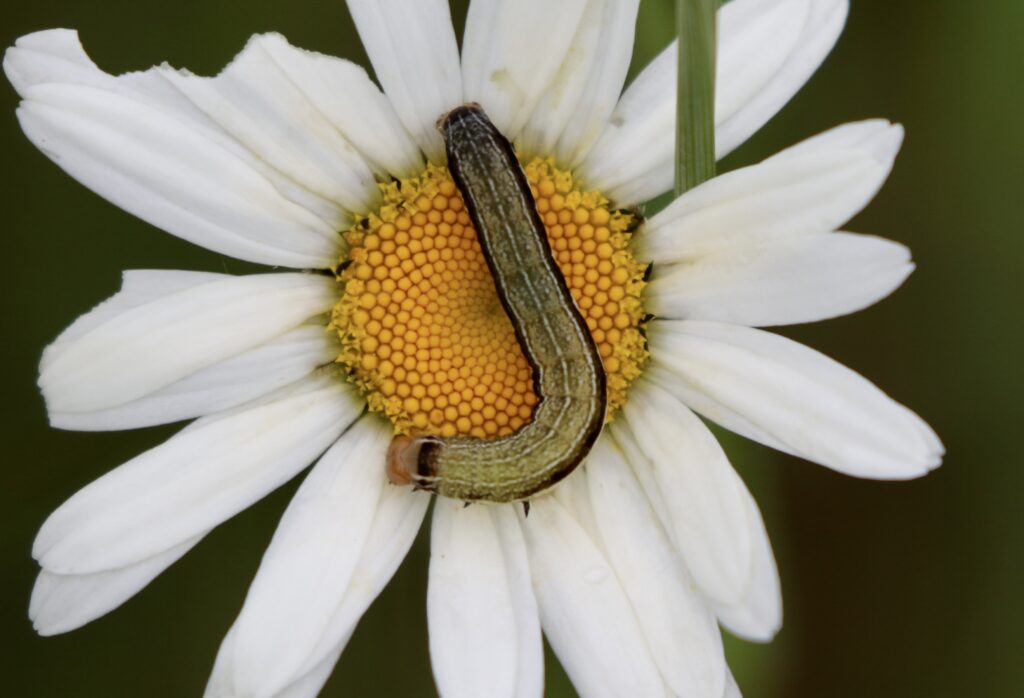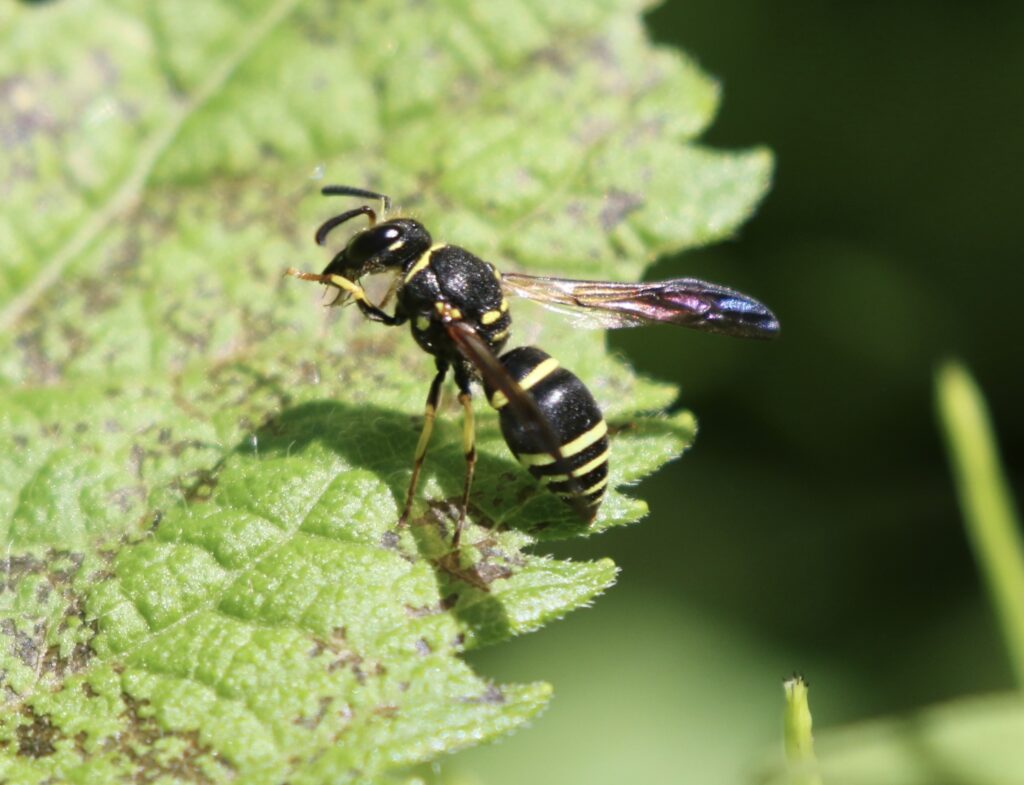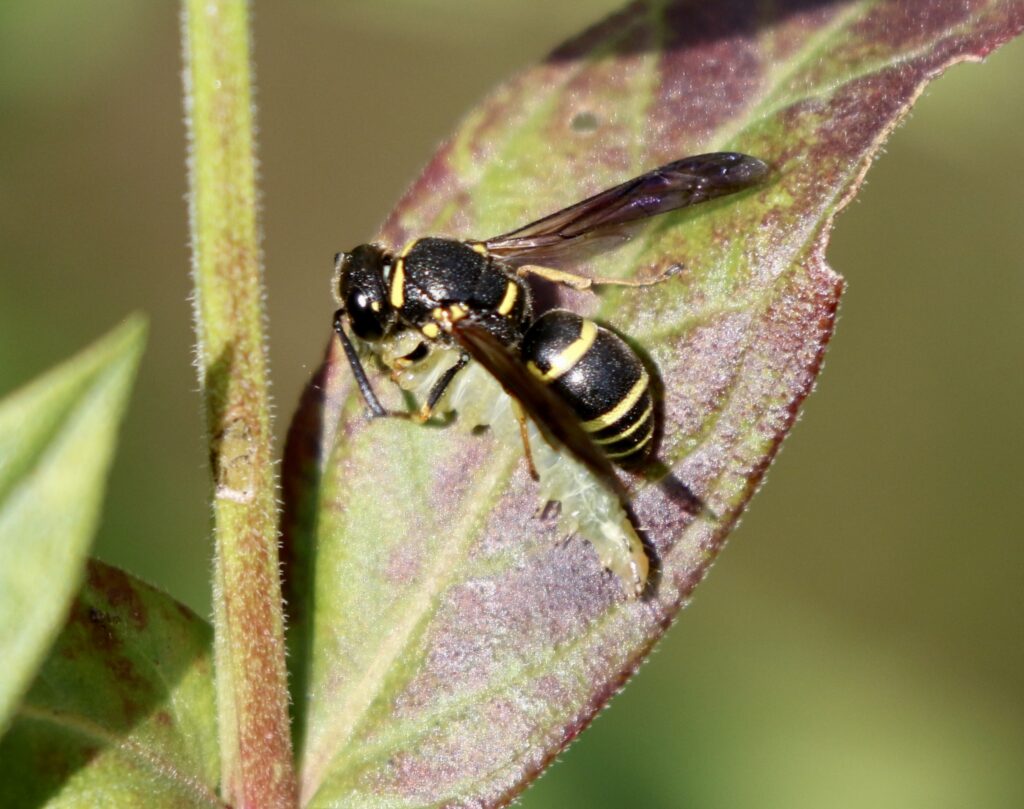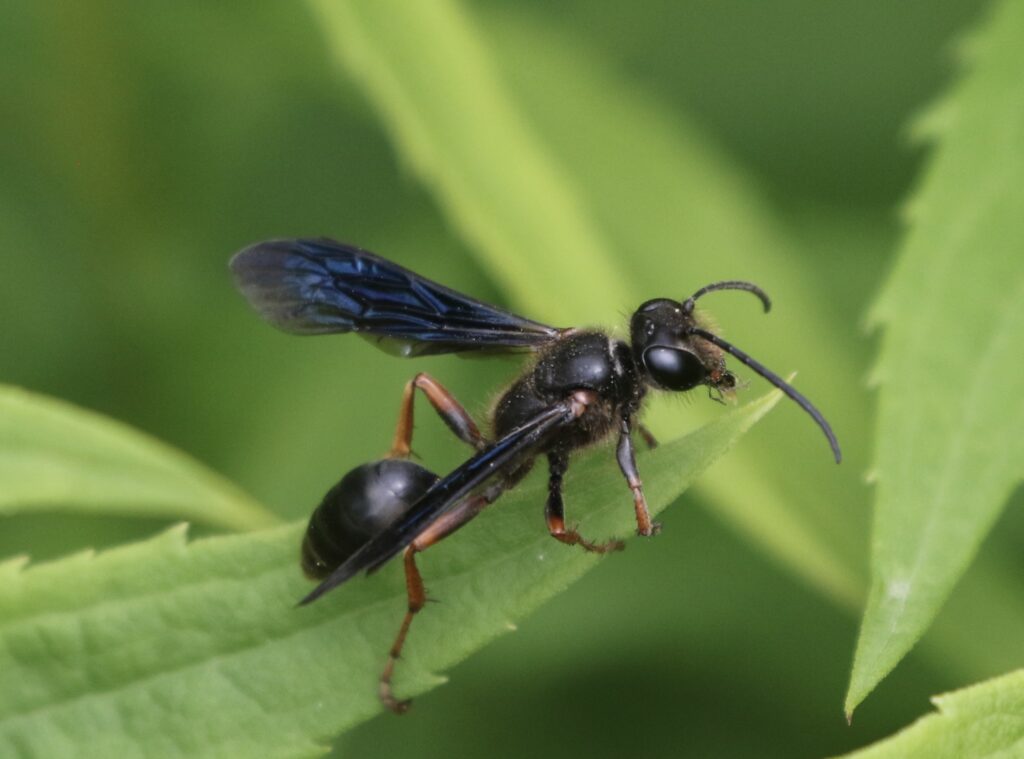Over the past summer, I became fascinated by flower-visiting wasps, especially the solitary kind that build individual nests, either by burrowing into the ground or by fashioning small mud-nests that they attach to plants or artificial constructions.
For one thing, these wasps are plentiful where I live in Toronto, Ontario. Throughout the summer and into the fall, I see dozens of them, and usually of several different species, every time I visit one of the local parks or natural areas. All I have to do is find a stand of milkweed or boneset, or goldenrod and asters, and there are the wasps, feeding on the flower nectar and hunting their insect prey. That prey consists for the most part of different types of caterpillars but can also include cicadas, grasshoppers, stinkbugs, spiders, or bees.

Another consideration is that these wasps are beautiful, more slender, streamlined, and elegant than their cousins the bees. Their color scheme may be basic—a black or dark brown foundation with markings in white or yellow—but that only seems to complement their simplicity of structure.

Wasps get a bad rap because of their ability to sting. More on that later, but usually it’s only social wasps, such as yellowjackets, that sting human beings on anything approaching a regular basis. For the most part, the flower-visiting wasps that I pursue are as placid as bumblebees. Getting a photo often involves bushwacking through stands of weeds and wildflowers, but I’ve never been stung while engaged in this activity. Moving slowly and taking the most basic precautions will usually result in a threat-free photo session.
Following is just a small selection of the wasps I’ve found and photographed over the past few years. I’ve identified them by using the online resource iNaturalist and by reference to Heather Holm’s fine field guide, Wasps: A Guide for Eastern North American (Pollination Press, 2021).
Maybe my favorite find this summer was of a Cross Potter Wasp, Eumenes crucifer, that I saw in Taylor Creek Park on June 10. This is a relatively uncommon wasp in the Greater Toronto Area, and it has an unusual structure, with its abdomen in two segments, one small, one large. The white markings are very bright and arranged in a way that is pleasing to the eye. On this wasp, the only color that isn’t white or black is the hint of orange that appears in the joints of the legs.

High Park, in Toronto’s west end, is the largest park in the city and contains one of the few viable remnants of the Carolinian forest that at one time covered the entire area. Much of the park consists of an extensive Black Oak savannah on sandy soil. It’s the only place in Toronto where you can still find the magnificent Cicada-killer Wasp, Sphecius speciosus, which digs burrows in the exposed sand and then stuffs the cavities with the bodies of Dog-day Cicadas, Neotibicen canicularis, to nourish its larvae. This is a hornet-sized wasp with red wings, legs, and eyes, and a prominent scarlet patch on the thorax.

On August 21, I was back in Taylor Creek, where I found several Wood-boring Mason Wasps, Euodynerus foraminatus. This is one of the wasps that hunts moth caterpillars to feed its young. I finally spotted and was able to photograph a wasp that had just killed a small caterpillar and was preparing to convey it to its nest.

Another of my personal favorites is the Four-banded Stink Bug Wasp, Bicyrtes quadrifasciatus. This is one of the more common wasps in the Toronto area, but I never get tired of seeing its strongly marked abdomen with four white slashes and its green oval eyes. As its name indicates, this wasp hunts down various kinds of stink bugs to provision the nests it digs in sandy soils.

Not all flower-visiting wasps dig their nests in sandy soil. The Brown-legged Grass-carrying Wasp, Isodontia auripes, often uses abandoned bee nests, hollow plant stems, or burrows that a beetle has made in dead tree trunks. Instead of hunting caterpillars, this wasp specializes in katydid nymphs and tree crickets. The fact that different species of wasps hunt different types of prey helps to explain why you can find several species in the same habitat.

I wanted to end this tribute to flower-visiting wasps with a brief account of my personal experience with yellowjackets. Like most people who spend much time out of doors, I’ve been stung by this type of wasp on more than one occasion. Most of these attacks were completely unprovoked. Yellowjackets just seem to take a perverse pleasure in finding a patch of exposed skin to sink their stinger into. My wife and I have an allotment garden where, for many years, we kept a plastic compost bin. The yellowjackets drove me nuts for several years by appropriating the bin as a nesting site. I tried different methods of discouraging them, including beating on the side of the bin with a baseball bat, but nothing worked.
One year in early autumn, I lifted the lid off the bin and saw a dozen yellowjackets clinging to a paper nest they’d just started to build on one wall. When the lid came off and a sunbeam hit the nest, the wasps flinched. They all made the same slight movement at the exact same moment, and in that movement I could feel their fear. Something odd happened to me then. For the first time in my life, I pitied these insects that I had always hated before. Without another thought, I replaced the lid on top of the bin and never bothered them again.


I cut back the growth on the west side of my city lane-way parking pad every once in a while, so that I can continue to park our car, but I let the golden rod, which grows on the east side of the lot, to fluorish, because the bees and wasps enjoy it. They never bother me, and I feel that I am doing some “pollinator good.” Now I’ll look more carefully to see which species are foraging here. Thanks, Ed, for opening my eyes to them.
Vid